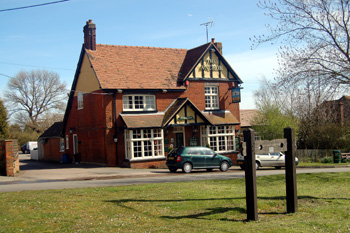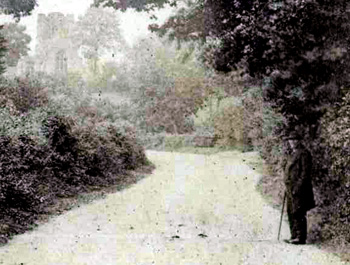There is an arresting tombstone in Tilsworth churchyard with the following inscription:
This Stone was erected
by subscription
TO THE MEMORY OF
A FEMALE UNKNOWN
found murdered in Blackgrove Wood
AUG 15 1821
Oh pause my friends & drop the silent tear,
Attend & learn why I was buried here;
Perchance some distant earth had hid my clay
If I'd outliv'd the sad, the fatal day.
To you unknown my case not understood
From whence I came or why in Blackgrove Wood
This truth's too clear & nearly all that's known
I there was murder'd! & the villains flown
May God whose piercing eye persues his flight
Pardon the crime but bring the deed to light

Grave of the murder victim - close-up of the text March 2008
The Northampton Mercury of 18th August 1821 reported the crime: "Shocking Murder. - On Wednesday evening last [15th August], at about a quarter-past seven o'clock, a decent, well-dressed female was found in Blackgrove Wood, in the parish of Tilsworth, Beds, with her throat cut in two places, and otherwise much mangled and bruised. She had on a light printed cotton gown, flounsed, small pattern, the colours red and blue, on a white ground; black velvet shoes and white stockings. She has light-brown hair, with false curls; and the little finger on the right hand grown crooked at the first joint. She is supposed to have worn a light-coloured beaver hat, tied with a black riband [sic], and a scarlet shawl. The deceased appears to be about 25 years of age. - The body now lies at the public house at Tilsworth, to be owned. - We are sorry to add, no traces of the murderer have yet been discovered".

The Anchor Public House March 2008
The only public houses known in Tilsworth at this date are the Anchor and the Bull, on Watling Street, today just on the southern outskirts of Hockliffe. Blackgrove Wood is in the diametrically opposite corner of the parish to the Bull, the south-west and so it would have been a long journey between the two places. Thus it seems more likely that the body would have been taken to the public house in the centre of the village, closer to the scene of the crime.

Tilsworth church from the north-west December 2008 - Blackgrove Wood is on the extreme right in the distance
The following edition, 25th August, noted: "Horrid Murder. - Yesterday se'nnight [sevennight, i.e. a week] an Inquisition was taken at Tilsworth, Beds, before Thomas Times, gent. coroner for the county of Bedford, on view of the body of a female unknown (the particulars of which were given in our last), who was found on the Wednesday preceding in Blackgrove Wood, with her throat cut. - The Deceased appeared to be about 30 years of age, and from the evidence produced to the Jury, they had no hesitation in pronouncing a verdict of Wilful Murder against some Person or Persons unknown".

Unknown murder victim's gravestone about 1920 [Z1130/124]
Finally, on 3rd September, the paper reported: "Further particulars of the unfortunate female who was found murdered in Blackgrove Wood, near Dunstable, Beds: - She had on a light-colour chintz-pattern, printed cotton gown, closely sprigged with pink and small blue flowers, white dimity petticoat, white cotton stockings, and low velvet shoes, had round her neck a white muslin frill, a man's jaconot muslin neckerchief, marked with blue marking thread, "T.S." and a pink check muslin handkerchief, such as is often worn by gentlemen; she was about five feet, four inches high, dark hair, with false curls in the front, of a lighter colour than her own hair, dark complexion, hazel eyes, small teeth, which appeared to be decaying; rather thin made, about 30 years of age, and the little finger on the right hand crooked at the first joint. - She is supposed to have been at Dunstable on Sunday the 12th, and at the Plough Public House [presumably the Plough in Kensworth, on Watling Street, which closed in 1864], between that place and Market Street, on Monday the 13th ult. in company with a man of the following description, viz.: - a healthy-looking man, about 30 years of age, round face, sallow complexion, brown hair, dark whiskers, and had generally the appearance of a gentleman's servant, about five feet eight inches high, had a fine shirt with a high collar, light fustian coat, yellow kerseymere waistcoat, light breeches, light worsted stockings, and either ancle [sic] shoes or high shoes, had a small bundle tied up in a light handkerchief, and a stick. The woman, when found, had not any head dress or shawl, but from the best information that has been obtained respecting her, she had on when seen as above stated, a brown beaver hat, and a red woollen shawl, but no traces whatever have been discovered as to who the unfortunate woman was, although every possible exertion has been used for that purpose".

Mr Horn the verger about 1875 [P130/28/5/13]
No one ever did discover who she was, or why she died, though a domestic dispute is clearly implied by the evidence. Frederic Augustus Blaydes wrote of the case in Bedfordshire Notes and Queries Volume I [1886], pages 86 and 87: "In the churchyard is a stone with the following remarkable inscription. It is an object of curiosity to all visitors, and probably has been frequently copied, though I have never yet seen it in print. "Master" Horne, the old parish clerk, told me that he was one of the first, if not the first, to discover the body of this unfortunate woman, whose identity has never to this day been discovered; nor was the murderer ever discovered. It appears that the murderer and his victim were seen to walk in the direction of Blackgrove wood, which is within sight of Tilsworth Church. I have been told, however, that a man named Evestaffe confessed to the murder on his deathbed. He had been tried, I believe, on suspicion, but there being no evidence to convict, he was acquitted".
Blaydes must have forgotten that he had a press cuttings book [AD4000/1] shich gave details of the man's trial, reported in March 1828, as follows: On Monday last, John eavestaff was examined before - Roach, Esq., and - Easdon, Esq., Magistrates at Dunstable charged with the murder of his wife, in Black Grove Wood, near Leighton Buzzard, in the autumn of 1822".
"James Hewitt, of Stanbridge, swore that he saw a female who was found murdered in 1822, in Black Grove Wood, in the company of a man, on the day before Dunstable fair. After cautiously examining the faces of the spectators on the various benches, he pointed out the prisoner, and said, "I believe that to be the man". No constable was at the time with Eavestaff, and at least sixty persons were sitting above and below him".
"Eavestaff: What clothes had I on when you saw me?"
"Witness: If you are the right man, and I do believe you are, though I cannot positively swear it, you wore a velveteen jacket, light waistcoat, corduroy breeches, and high-low shoes".
"The prisoner shook his head, but said no more".
"Hewitt then withdrew, and Eavestaff was removed to another seat, previous to the examination of an elderly female, who gave similar testimony".
"The psironer was remanded uill evening, and he then called witnesses"
"James Smith stated, that he recollected the time the murder was committed. The prisoner was at this time in his employ at Leighton, and was reaping in one of his fields on the day the body was found, as well as the preceding and succeeding days".
"The second witness was Mrs. Downey, the mother of the prisoner's first wife. She was a very infirm woman, upwards of seventy years of age, and did not take the slightest notice of the prisoner. She said she did not know anything at all of her daughter, or whether she was dead or alive. To the best of her recollection it was six or seven years since she had seen her. It could not be so little as four years - yet, perjaps, it might, her memory being very bad".
"The prisoner was remanded, and was ordered to be conveyed to Leighton Buzzard till the arrival of some depositions from London, when he will be finally examined. If he should be committed, his trial cannot take place till August next".